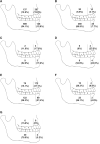Frequency of Odontogenic Tumors: A Single Center Study of 1089 Cases in Japan and Literature Review
- PMID: 34716904
- PMCID: PMC9187835
- DOI: 10.1007/s12105-021-01390-w
Frequency of Odontogenic Tumors: A Single Center Study of 1089 Cases in Japan and Literature Review
Abstract
Several attempts have been made to classify odontogenic tumors; however, the need for a uniform international classification system led the World Health Organization (WHO) to present a classification of odontogenic tumors in 1971. We aimed to evaluate the number and types of odontogenic tumors examined at the Tokyo Dental College Hospital in Japan to determine the frequency and types of odontogenic tumors, based on the 2017 WHO classification system, as this information has not been reported previously in Japan. We also compared the results of our evaluation with those reported in previous studies. We conducted a clinicopathological evaluation of odontogenic tumors examined at the Tokyo Dental College Hospital between 1975 and 2020. This included an analysis of 1089 cases (malignant, n = 10, 0.9%; benign, n = 1079, 99.1%) based on the 2017 World Health Organization Classification of Head and Neck Tumors. We identified 483 (44.3%), 487 (44.7%), and 109 (10.0%) benign epithelial odontogenic, mixed odontogenic, and mesenchymal tumors, respectively. The most common tumor types were odontoma (42.5%) and ameloblastoma (41.9%). Of the 1089 cases, 585 (53.7%) and 504 (46.3%) were male and female patients, respectively. Ameloblastoma and ameloblastic fibroma occurred more commonly in male patients, whereas odontogenic fibroma and cemento-ossifying fibroma affected female patients primarily. The age at diagnosis ranged from three to 87 (mean, 29.05) years. In 319 (29.3%) patients, the age at diagnosis ranged from 10 to 19 years. Ameloblastoma and odontoma were the most common tumor types among patients in their 20s and those aged 10-19 years, respectively. In 737 (67.7%) and 726 (66.7%) patients, the tumors were located in the mandible and posterior region, respectively. Ameloblastoma was particularly prevalent in the posterior mandible. Odontogenic tumors are rare lesions and appear to show a definite geographic variation.
Keywords: Classification; Epidemiology; Odontogenic tumors; Oral Pathology; World Health Organization.
© 2021. The Author(s), under exclusive licence to Springer Science+Business Media, LLC, part of Springer Nature.
Conflict of interest statement
All authors declare that they have no conflicts of interest.
Figures
Similar articles
-
Odontogenic tumours in a Chilean population: a retrospective study of 544 cases based on 2022 WHO classification.Med Oral Patol Oral Cir Bucal. 2023 Nov 1;28(6):e596-e606. doi: 10.4317/medoral.26008. Med Oral Patol Oral Cir Bucal. 2023. PMID: 37823289 Free PMC article. Review.
-
Odontogenic tumors: a review of 319 cases in a Nigerian teaching hospital.Oral Surg Oral Med Oral Pathol Oral Radiol Endod. 2005 Feb;99(2):191-5. doi: 10.1016/j.tripleo.2004.08.031. Oral Surg Oral Med Oral Pathol Oral Radiol Endod. 2005. PMID: 15660091
-
A review of 318 odontogenic tumors in Kaduna, Nigeria.J Oral Maxillofac Surg. 2005 Jun;63(6):811-9. doi: 10.1016/j.joms.2004.03.022. J Oral Maxillofac Surg. 2005. PMID: 15944979
-
Odontogenic tumors.J Craniofac Surg. 2013 Sep;24(5):1521-5. doi: 10.1097/SCS.0b013e3182997aaf. J Craniofac Surg. 2013. PMID: 24036718
-
Pediatric Odontogenic Tumors.Pediatr Dev Pathol. 2023 Nov-Dec;26(6):583-595. doi: 10.1177/10935266231200115. Epub 2023 Nov 30. Pediatr Dev Pathol. 2023. PMID: 38032744 Review.
Cited by
-
Improving Diagnostic Performance for Head and Neck Tumors with Simple Diffusion Kurtosis Imaging and Machine Learning Bi-Parameter Analysis.Diagnostics (Basel). 2025 Mar 20;15(6):790. doi: 10.3390/diagnostics15060790. Diagnostics (Basel). 2025. PMID: 40150132 Free PMC article.
-
Frequency and Demographic Analysis of Odontogenic Tumors in Three Tertiary Institutions: An 11-Year Retrospective Study.Diagnostics (Basel). 2024 Apr 26;14(9):910. doi: 10.3390/diagnostics14090910. Diagnostics (Basel). 2024. PMID: 38732324 Free PMC article.
-
Implant-supported prosthetic rehabilitation after Ameloblastomas treatment: a systematic review.BMC Oral Health. 2023 Dec 18;23(1):1013. doi: 10.1186/s12903-023-03765-7. BMC Oral Health. 2023. PMID: 38110933 Free PMC article.
-
A three-dimensional quantitative assessment on bony growth and symmetrical recovery of mandible after decompression for unicystic ameloblastoma.Sci Rep. 2024 Jul 5;14(1):15492. doi: 10.1038/s41598-024-66411-4. Sci Rep. 2024. PMID: 38969711 Free PMC article.
-
Title of the article: diagnostic markers for odontogenic tumors: an insight: a review.Discov Oncol. 2024 Oct 15;15(1):558. doi: 10.1007/s12672-024-01237-0. Discov Oncol. 2024. PMID: 39404913 Free PMC article. Review.
References
-
- Regezi JA, Sciubba JJ, Jordan RC. Oral pathology: clinical pathologic correlations. 7. St. Louis: Elsevier; 2016. p. 402.
-
- Pindborg JJ, Kramer IR, Torloni H. Histological typing of odontogenic tumours, jaw cysts, and allied lesions. Geneva: World Health Organization; 1971. p. 43.
-
- Kramer IRH, Pindborg JJ, Shear M. Histological typing of odontogenic tumours. Berlin: World Health Organization, Springer; 1992. Histological classification of odontogenic tumours; pp. 7–9.
Publication types
MeSH terms
LinkOut - more resources
Full Text Sources
Medical


